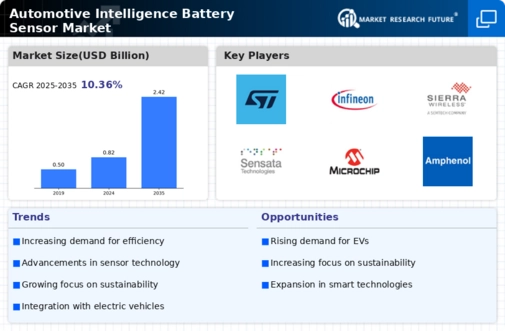Market Growth Projections
The Global Automotive Intelligence Battery Sensor Market Industry is projected to experience substantial growth over the next decade. With an anticipated market value of 0.82 USD Billion in 2024, the industry is expected to expand to 2.42 USD Billion by 2035. This growth trajectory indicates a compound annual growth rate (CAGR) of 10.34% from 2025 to 2035, driven by factors such as increasing electric vehicle adoption, technological advancements, and regulatory support for emission reductions. The market's expansion reflects the growing importance of battery management systems in enhancing vehicle performance and sustainability.
Growing Demand for Electric Vehicles
The increasing adoption of electric vehicles (EVs) is a primary driver for the Global Automotive Intelligence Battery Sensor Market Industry. As consumers and manufacturers prioritize sustainability, the need for advanced battery management systems becomes crucial. In 2024, the market is projected to reach 0.82 USD Billion, reflecting the heightened focus on optimizing battery performance and longevity. Battery sensors play a vital role in monitoring health, temperature, and charge levels, which enhances the overall efficiency of EVs. This trend is expected to accelerate as global regulations favor electric mobility, further propelling the market's growth.
Regulatory Support for Emission Reductions
Government regulations aimed at reducing emissions are a critical factor driving the Global Automotive Intelligence Battery Sensor Market Industry. Many countries are implementing stricter emission standards, which compel automotive manufacturers to invest in cleaner technologies, including advanced battery systems. The integration of battery sensors is essential for compliance with these regulations, as they enable precise monitoring of battery performance and emissions. As a result, the market is expected to experience a compound annual growth rate (CAGR) of 10.34% from 2025 to 2035, reflecting the increasing emphasis on sustainable automotive solutions.
Rising Consumer Awareness of Battery Efficiency
Consumer awareness regarding battery efficiency and performance is increasingly influencing the Global Automotive Intelligence Battery Sensor Market Industry. As individuals become more informed about the benefits of advanced battery technologies, they are more likely to demand vehicles equipped with sophisticated battery management systems. This shift in consumer preferences is prompting manufacturers to adopt innovative battery sensor technologies that enhance vehicle performance and longevity. Consequently, the market is poised for substantial growth, as manufacturers strive to meet the evolving expectations of environmentally conscious consumers.
Expansion of Automotive Electrification Initiatives
The global push towards automotive electrification is a significant driver for the Global Automotive Intelligence Battery Sensor Market Industry. Various governments and organizations are promoting initiatives to transition from traditional combustion engines to electric and hybrid vehicles. This transition necessitates the implementation of advanced battery management systems, where battery sensors play a pivotal role in ensuring optimal performance and safety. As the automotive industry embraces electrification, the demand for battery sensors is expected to surge, contributing to a robust market growth trajectory.
Technological Advancements in Battery Management Systems
Technological innovations in battery management systems (BMS) are significantly influencing the Global Automotive Intelligence Battery Sensor Market Industry. Enhanced sensor technologies, such as lithium-ion battery sensors, provide real-time data on battery conditions, which is essential for maximizing performance and safety. These advancements not only improve the reliability of battery systems but also contribute to the overall efficiency of electric and hybrid vehicles. As the market evolves, the integration of artificial intelligence and machine learning into BMS is anticipated to drive further growth, with projections indicating a market value of 2.42 USD Billion by 2035.


























Leave a Comment